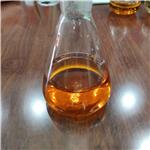Chemical Properties
Castor oil fatty acid, also known as ricinoleic acid, is a long-chain unsaturated hydroxy acid. It is yellow viscous oily liquid. It is soluble in ethanol, acetone, ether and chloroform, but insoluble in water.
Characteristics
The presence of both hydroxy and carboxy groups in the molecule of ricinoleic acid enables it to undergo intermolecular esterification, thus resulting in the formation of the oligomeric ricinoleic acid. The oligomeric ricinoleic acid with different acid value (which is an indirect index for oligomerization degree) has different applications. For example, as an additive in shampoos, the oligomeric ricinoleic acid with an acid value of 60–90 mg KOH/g is required while for cosmetic formulations, an acid value of 20–40 mg KOH/g is suitable. The oligomeric ricinoleic acid can also be used as lubricant for metal cutting oils due to its appropriate viscosity, good adsorptivity and film formation ability on metal surfaces.
Uses
Ricinolic Acid is a metabolite of linoleic acid from Lactobacilli and has antifungal activity in bread. Ricinolic Acid is also a metabolite of castor oil and has shown to activate intestinal and uterine smooth-muscle cells through EP3 prostanoid receptors inducing diarrhea and labor in pregnant females.
Definition
ChEBI: (9E)-12-hydroxyoctadec-9-enoic acid is a hydroxy fatty acid that is (9E)-octadec-9-enoic (elaidic) acid carrying a hydroxy substituent at position 12. It is a hydroxy fatty acid, a long-chain fatty acid and a hydroxy monounsaturated fatty acid. It is functionally related to an elaidic acid. It is a conjugate acid of a (9E)-12-hydroxyoctadec-9-enoate.
Preparation
Ricinoleic acid can be easily prepared by hydrolysis of castor oil.




